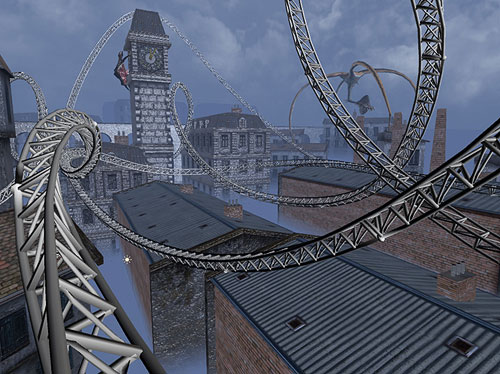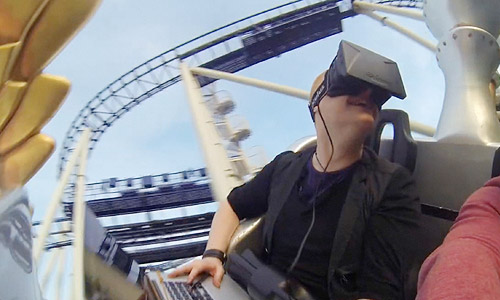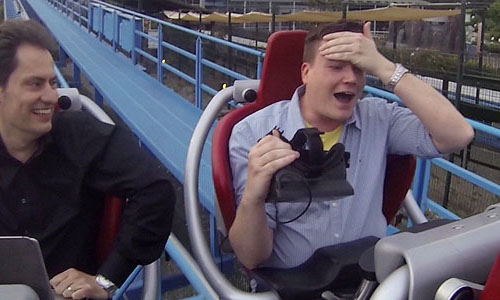A rollercoaster company in Germany called Mack Rides joined forces with a team of virtual reality developers in the spring of 2014 to create an experience like no other.
The idea came from [Thomas], a professor at the University of Applied Sciences Kaiserslautern who was working in the department of Virtual Design at the time. The thought of extending a real rollercoaster ride with an Oculus Rift was an intriguing one, so he approached Mack Rides with the experiment, and the ground-breaking research began.
Hundreds of tests were done over the following weeks and months, which provided insight into how we perceive time and space while inside VR. This led to some interesting discoveries. For one, the VR track inside the Rift could be more complex than the real one. This meant that the directions could be contorted into different angles without the user feeling much of a difference. Knowing this, the developers were able to unfold/extend the track well beyond what was possible in real life.
Another epiphany had to do with the rails, which actually didn’t have to be present in VR at all. In fact, it was better if the tracks weren’t there because the experience was much more exciting not knowing which way the ride was suddenly going to take. This made things exponentially more surprising and compelling.
By far the most startling revelation was the reduction in dizziness and motion sickness during the tests. This was attributed to the complex synchronization that the mind goes through when melding together g-forces and the actual rollercoaster rides with the virtual ones displayed inside the Oculus Rift.


In this project, the virtual reality goggles acted like an augmented filter that could be added to the speedy, thrilling rollercoaster ride, drastically altering the experience. Yet, at the same time, the rollercoaster itself almost resembled a haptic feedback system for the virtual reality device giving the wearer a sense of perception that they normally would not feel in a typical VR experience at home. The blending of all of this made it hard to tell exactly where the VR space began, and whether or not this should be considered AR or not.
Obviously, people are going to ask “what’s the point here?” It’s understandable to think that virtual reality is meant for indoor use and that strapping on a headset on a rollercoaster ride is figuratively taking the person out reality, making them ignorant to what is going on around them. However, it seems like this experiment is more like the melding of two worlds (the physical and the virtual). Not only does this project push the boundaries of what VR can do, but it shows that our minds can be easily tricked into experiencing something more. And if you do it right, the side-effects involved (like motion sickness) can be eliminated due to a perfect combination of hardware, software, and centrifugal forces. It’s an amazing discovery that should be applauded, and the research discovered here will surely influence the work of virtual reality developers in the future.

















that must be epic
“whether or not this should be considered AR or not”
This is augmenting reality, literally the meaning of AR. Perhaps it was meant to read VR? Because I can agree that this is not VR, but AR. which are well enough defined to not need to describe something as the blending of VR and Reality.
I can see the argument, because AR usually adds on to a sense, doesn’t completely replace it. I would agree with you, however, that this clearly is AR but not VR.
Also when did HaD turn into TechNews? This isn’t even remotely a hack.
Hack the mind.
Nothing is VR. It is oxymoronic. Before Jaron Lanier invented the term it was known as “immersive simulation”.
Most people don’t even know who Jaron Lanier is. Met him once at a bookstore, and barely anyone there had any idea that he helped start the ‘immersive simulation’ movement. https://twitter.com/industrychanger/status/459197957238034433
Sight actually has a lot to do with the perception of time. For example, if you close your eyes while riding in a car (as passenger of course) you experience the illusion that time is slowing down. You think 20 minutes have passed when really only 5 have.
Or at least, that is my experience.
Oculus Rift plus roller coaster equals Live Action Rail Shooter or LARS. You can look all around but your path is always the same. One of the lamest types of video games ever. Everything is predetermined and once you learn where all the traps etc are they are pitifully easy to max the score on.
What would work just as well is putting enclosed cars on the track with high resolution video screen “windows”. Then you’d have the equivalent of putting the first version of Star Tours on a coaster track.
The original Star Tours never lived up to the hype. It was pitched as a ride that would never get old because all they had to do to make it new was to do new video and reprogram the motion platforms… but for twenty-three years they didn’t change one damn thing and all of the simulators at each park all had the same ride. I rode the original in Disneyland one time in 1987, was no reason to ever go on it again.
The prequel redesign of the rides uses several ‘canned cycles’ of motion and video which can be strung together in over 50 different ways. They *could* have done that with the original but apparently lacked the ambition to just go ahead and do it, or Disney and Lucas didn’t want to gamble on spending the money. (As if a STAR WARS anything would ever be a money loser!)
Crazy to think but even mighty Disney sometimes balks a bit at the cost of things. Look up the history of the “submarines” at Disneyland and how they almost got deep-sixed (like the Disneyworld ones) before the company decided to spend the $$$$$ to rebuild, re-engineer and redesign it with a Finding Nemo theme.
You hardly need the rails at all though. There have been those VR rides where you get in a little box on hydraulics and it can feel like you’re doing loops and flying just by tilting.
There’s a big difference between a real roller coaster and a stewart-platform-thingy using wash-out algorithms, when it comes to forces.
They Simpson’s Ride at Orlando Universal Studios is a great example of how to do this type of ride well. You sit in a rollercoaster car that is mounted on a 6 dof table and it moves along with a video that wraps around the car. You really feel like you’re on a rollercoaster and then all hell breaks lose and it does some crazy stuff that rollercoasters can’t do. At one point it feels like you do a barrel roll even though you probably never tilt more than 45 degrees. It would be interesting to take a 6 dof accelerometer and a data logger on the ride to see what it’s like.
Hmmm, I’m going there in November. There’s still time to make that happen!
I hope they make all stuff open-source (3D models, sync APIs etc.) so people can create their own rides. I can’t wait to see mind bending scenes created by communities (blender?), interactive multiplayer stuff etc. Imagine a ride, where people on the ground could shoot you! :)
IMHO a very clever idea. Wish I’d thought of it. Very cool.
Add this to a Kuka Robot, and you have a real win.
https://www.youtube.com/watch?v=R8Rmtome3yQ
This is better
https://www.youtube.com/watch?v=bxbjZiKAZP4
“Another epiphany had to do with the rails, which actually didn’t have to be present in VR at all. In fact, it was better if the tracks weren’t there…”
No rails? Have any of these people even been to Space Mountain? A ride so old that the original corporate sponsor (Radio Corporation of America) no longer exists.
I find it amusing how much of this project’s experimentation and the comment’s musings have been used by Disney to entertain millions of people over decades.
There is nothing wrong with that. It isn’t a criticism. Merely pleasant confirmation that all those attractions at Disney World really are as intensely technologically cool as they are fun to ride.
What I want to know is, is it as scary to ride a rollercoaster with VR goggles on as it is riding a real one?
If the track fails the goggles would make it far less scary.
FWIW, I get motion sick quite easily, but, by using an easy trick, I was able to take a ride years ago that normally would have me puking. What did I do? Simple. I strapped myself into the cockpit of my X-Wing, and proceeded to open a can of whoopass on some TIE’s! This would be even sweeter, especially since, by just ‘fudging’ the motion a little, the ‘rail’ can be made flexible, allowing for a lot more openness in the experience. Have each person sit in a powered 360 degree swiveling seat, and they can man a turret on a heavy fighter in Star Wars or Star Citizen!
Huzzah! Science has developed a new way to make us vomit!
Why bother with virtual reality? Why not build your own rollercoaster in the sky? How about 0-60 in 5s, climb with your feet higher than your head, pull >3G, “depart from controlled flight”, fly with raptors, and much much more.
Before you go solo you’ll be doing this http://www.youtube.com/watch?v=KKWuS_jLFHE http://www.youtube.com/watch?v=8fZxuTKmmAU
And this is a 14yo solo pilot http://www.youtube.com/watch?v=ET0x0PB2M7
When you finally get good… http://www.youtube.com/watch?v=Dhac_vWKWyg